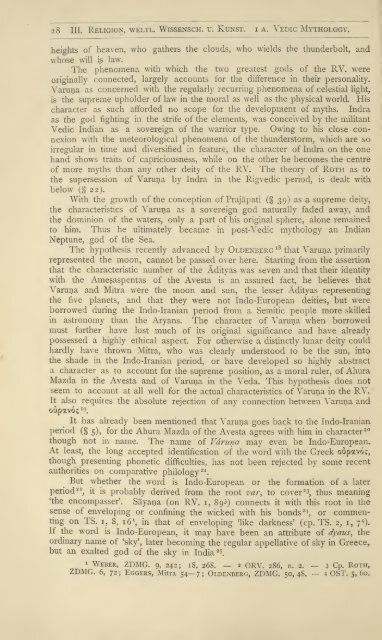Create successful ePaper yourself
Turn your PDF publications into a flip-book with our unique Google optimized e-Paper software.
28 III. RELIGION, WELTL. WISSENSCH. u. KUNST. i A. VEDIC MYTHOLOGY.<br />
heights of heaven, who gathers the clouds, who wields the thunderbolt, and<br />
whose will is law.<br />
The phenomena with which the two greatest gods<br />
of the RV. were<br />
originally connected, largely accounts for the difference in their personality.<br />
Varuna as concerned with the regularly recurring phenomena of celestial light,<br />
is the supreme upholder of law in the moral as well as the physical world. His<br />
character as such afforded no scope for the development of myths. Indra<br />
as the god fighting in the strife of the <strong>Vedic</strong> Indian as a<br />
elements, was conceived by the militant<br />
sovereign of the warrior type. Owing to his close con<br />
nexion with the meteorological phenomena of the thunderstorm, which are so<br />
irregular in time and diversified in feature, the character of Indra on the one<br />
hand shows traits of capriciousness, while on the other he becomes the centre<br />
of more myths than any other deity of the RV. The theory of ROTH as to<br />
the supersession of Varuna by Indra in the Rigvedic period, is dealt with<br />
below ( 22).<br />
the<br />
With the growth of the conception of Prajapati ( 39) as a supreme deity,<br />
characteristics of Varuna as a sovereign god naturally faded away, and<br />
the dominion of the waters, only a part of his original sphere, alone remained<br />
to him. Thus he ultimately became in post-<strong>Vedic</strong> <strong>mythology</strong> an Indian<br />
Neptune, god<br />
of the Sea.<br />
The hypothesis recently advanced by OLDENBERG IS that Varuna primarily<br />
represented the moon, cannot be passed over here. Starting from the assertion<br />
that the characteristic number of the Adityas was seven and that their identity<br />
with the Amesaspentas of the Avesta is an assured fact, he believes that<br />
Varuna and Mitra were the moon and sun, the lesser Adityas representing<br />
the five planets, and that they were not Indo-European deities, but were<br />
borrowed during the Indo-Iranian period from a Semitic people more skilled<br />
in astronomy than the Aryans. The character of Varuna when borrowed<br />
must further have lost much of its original significance and have already<br />
possessed a highly ethical aspect. For otherwise a distinctly lunar deity could<br />
hardly have thrown Mitra, who was clearly understood to be the sun, into<br />
the shade in the Indo-Iranian period, or have developed so highly abstract<br />
a character as to account for the supreme position, as a moral ruler, of Ahura<br />
Mazda in the Avesta and of Varuna in the Veda. This hypothesis does not<br />
seem to account at all well for the actual characteristics of Varuna in the RV.<br />
It also requires the absolute rejection of any connection between Varuna and<br />
It has already been mentioned that Varuna goes back to the Indo-Iranian<br />
period ( 5), for the Ahura Mazda of the Avesta 20<br />
agrees with him in character<br />
though not in name. The name of Varuna may even be Indo-European.<br />
At least, the long accepted identification of the word with the Greek oopavoc,<br />
though presenting phonetic difficulties, has not been rejected by some recent<br />
authorities on 21<br />
.<br />
comparative philology<br />
But whether the word is Indo-European or the formation of a later<br />
period 22<br />
it is , probably derived from the root var, to cover 23 , thus meaning<br />
the . encompasser Sayana (on RV. i, 89^) connects it with this root in the<br />
sense of enveloping or confining the wicked with his bonds 24 or commen<br />
,<br />
ting on TS. i, 8, i6 x<br />
, in that of enveloping like darkness (cp. TS. 2, i, 7*).<br />
If the word is Indo-European, it may have been an attribute of dyaus, the<br />
ordinary name of sky , later becoming the regular appellative of sky in Greece,<br />
but an exalted god of the sky in India 2 ^.<br />
1 WEBER, ZDMG. 9, 242; 18, 268. 2 QRV. 286, n. 2, 3 Cp. ROTH,<br />
ZDMG. 6, 72; EGGERS, Mitra 547; OLDENBERG, ZDMG. 50,48. -- 4 OST. 5,60,

















